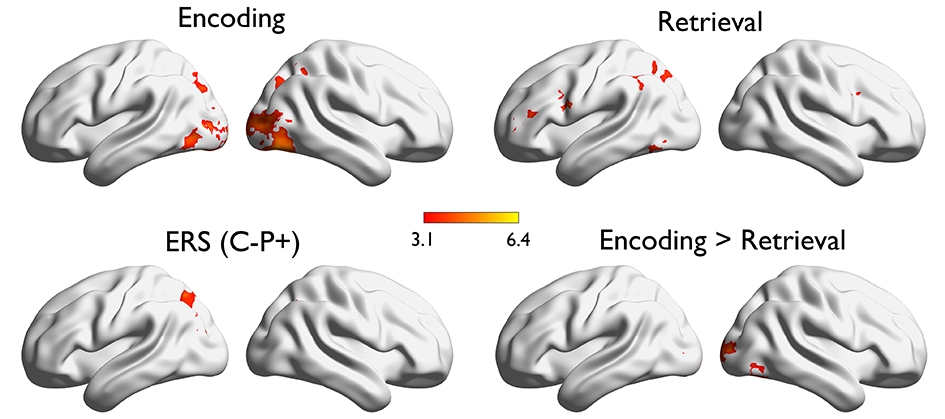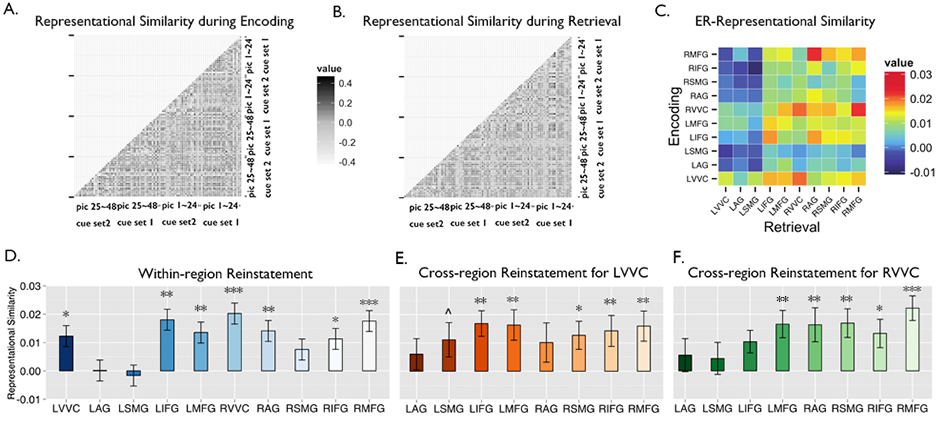In Feb. 2017, the research report “Transformed neural pattern reinstatement during episodic memory retrieval” by Prof. Xue’s group was published in the Journal of Neuroscience. This study is the first one directly compared the neural representational space during encoding and retrieval, which provided the novelty evidence that the retrieval representation actually shared the same representation structural with the encoding representation, in different brain regions.
Episodic memory enables humans to vividly re-experience past events, yet how this is achieved at the neural level is barely understood. A long-standing hypothesis posits that memory retrieval involves the faithful reinstatement of encoding-related activity. We tested this hypothesis by comparing the neural representations during encoding and retrieval.
Our results obtained clear evidence for item- specific pattern reinstatement in the frontoparietal cortex (FPC), even when the encoding-retrieval pairs shared no perceptual similarity. No item-specific pattern reinstatement was found in the ventral visual cortex (VVC). Importantly, the brain regions and voxels carrying item-specific representation differed significantly between encoding and retrieval, and the item-specificity for ERS was smaller than that for encoding or retrieval, suggesting different nature of representations between encoding and retrieval. Moreover, cross-region representational similarity analysis suggests that the encoded representation in the VVC was reinstated in the FPC during retrieval. Taken together, these results suggest that in addition to reinstatement of the originally encoded pattern in the brain regions that perform encoding processes, retrieval may also involve the reinstatement of a transformed representation of the encoded information.
These results suggest that memory retrieval is not a faithful replay of past event, but rather involves additional constructive processes to serve adaptive functions.
This work was sponsored by the National Natural Science Foundation of China (31130025), the 973 Program (2014CB846102), the 111 Project (B07008), and the NSFC project (31521063).

Figure 4. Whole-brain searchlight results. Item-specific representation for encoding and retrieval, their direct comparisons, and ERS were rendered onto a population-averaged surface atlas (Xia et al., 2013). All activations were thresholded using cluster detection statistics, with a height threshold of z > 3.1 and a cluster probability of p < 0.05, corrected for whole-brain multiple comparisons using Gaussian Random Field Theory (GRFT).

Figure 7. Cross-region pattern reinstatement. Representational similarity matrix for encoding (A) and retrieval phase (B). The data is from one ROI (i.e., LVVC) of one participant (subject No. 3). For each of the 48 pictures, the representational similarity matrix was obtained by calculating the pair-wise Pearson correlation of activation pattern between each of the 48 pictures and the other 23 pictures from different run (the same picture pairs were removed), separately for encoding and retrieval phase. C. Heat-map for group-averaged encoding-retrieval representational connectivity within and across brain regions. D. Bar graphs of within-region encoding-retrieval representational connectivity (i.e., within-region reinstatement). E and F show the bar graphs of across-region encoding-retrieval representational connectivity (i.e., cross-region reinstatement) for the left and right VVC, respectively. Error bars represent within-subject error.
